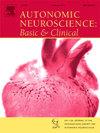Acute hyperoxia elicits decreases in muscle sympathetic nerve activity and action potential activation in a sex-dependent manner
IF 3.3
4区 医学
Q2 NEUROSCIENCES
引用次数: 0
Abstract
Acute hyperoxia (100 % oxygen) has been shown to reduce muscle sympathetic nerve activity (MSNA), suggesting that hyperoxia could be a potential strategy for lowering blood pressure. However, the efficacy of hyperoxia to reduce blood pressure (e.g., mean arterial pressure; MAP) remains unclear. Therefore, we compared MSNA and MAP responses to acute hyperoxia (1-min pokilocapnic + 3-min, PetO2 O2 + 300 Torr) between 18 females and 13 males. Baseline integrated total MSNA was not different between females and males (24 ± 7 vs 23 ± 8 bursts/min, respectively; P = 0.68) while MAP was lower in females than males (85 ± 7 vs 93 ± 7 mmHg; P < 0.01). Overall, hyperoxia evoked reductions in MSNA burst frequency (BF; P = 0.02) but not burst amplitude (BA; P = 0.82) or total MSNA (=BF ∗ BA; P = 0.26), To further probe these responses, 1-min nadir total MSNA response to hyperoxia were extracted within each participant. Total MSNA was reduced from baseline during nadir hyperoxia only in males (sex ∗ cond: P = 0.04). Females exhibited a bimodal distribution of sympatho-inhibitors (FI) and non-inhibitors (FNI). FNI demonstrated limited reductions in BF (P = 0.11 vs inhibitors) coupled with increases in BA (P < 0.01 vs inhibitors), resulting in no net change in total MSNA (P < 0.01 vs inhibitors). Mechanistically, action potential (AP) detection analyses revealed that FNI increased AP firing during hyperoxia (baseline: 313 ± 172 vs hyperoxia: 404 ± 192 spikes/min; P = 0.02), whereas hyperoxia blunted AP firing in FI (baseline: 387 ± 263 vs hyperoxia: 267 ± 199 spikes/min; P = 0.02). In sum, approximately 50 % of healthy females responded to acute hyperoxia with unexpected increases in AP firing. These data may suggest that benefit of hyperoxia as a sympatho-inhibitor may be limited in young and healthy females.

急性高氧引起肌肉交感神经活动和动作电位激活以性别依赖的方式减少
急性高氧(100%氧气)已被证明可以减少肌肉交感神经活动(MSNA),这表明高氧可能是降低血压的潜在策略。然而,高氧降低血压(如平均动脉压;MAP)仍不清楚。因此,我们比较了18名女性和13名男性对急性高氧(1分钟pokilapnic + 3分钟,PetO2 O2 + 300 Torr)的MSNA和MAP反应。基线综合总MSNA在女性和男性之间无差异(分别为24±7 vs 23±8次/分钟);P = 0.68),而MAP女性低于男性(85±7 vs 93±7 mmHg;P & lt;0.01)。总体而言,高氧诱发了MSNA突发频率(BF;P = 0.02),但没有爆发幅度(BA;P = 0.82)或总MSNA (=BF * BA;P = 0.26),为了进一步探讨这些反应,提取每个参与者对高氧的1分钟最低总MSNA反应。只有男性在最低点高氧时总MSNA较基线降低(性别* cond: P = 0.04)。雌性交感神经抑制剂(FI)和非抑制剂(FNI)呈双峰分布。FNI显示BF的有限减少(P = 0.11 vs抑制剂)以及BA的增加(P <;0.01 vs抑制剂),导致总MSNA无净变化(P <;0.01 vs抑制剂)。机制上,动作电位(AP)检测分析显示,FNI在高氧状态下增加了AP放电(基线:313±172 vs高氧状态:404±192;P = 0.02),而高氧降低了FI的AP放电(基线:387±263 vs高氧:267±199尖峰/分钟;p = 0.02)。总而言之,大约50%的健康女性对急性高氧的反应是意想不到的AP放电增加。这些数据可能表明,高氧作为交感神经抑制剂的益处在年轻和健康女性中可能有限。
本文章由计算机程序翻译,如有差异,请以英文原文为准。
求助全文
约1分钟内获得全文
求助全文
来源期刊
CiteScore
5.80
自引率
7.40%
发文量
83
审稿时长
66 days
期刊介绍:
This is an international journal with broad coverage of all aspects of the autonomic nervous system in man and animals. The main areas of interest include the innervation of blood vessels and viscera, autonomic ganglia, efferent and afferent autonomic pathways, and autonomic nuclei and pathways in the central nervous system.
The Editors will consider papers that deal with any aspect of the autonomic nervous system, including structure, physiology, pharmacology, biochemistry, development, evolution, ageing, behavioural aspects, integrative role and influence on emotional and physical states of the body. Interdisciplinary studies will be encouraged. Studies dealing with human pathology will be also welcome.

 求助内容:
求助内容: 应助结果提醒方式:
应助结果提醒方式:


